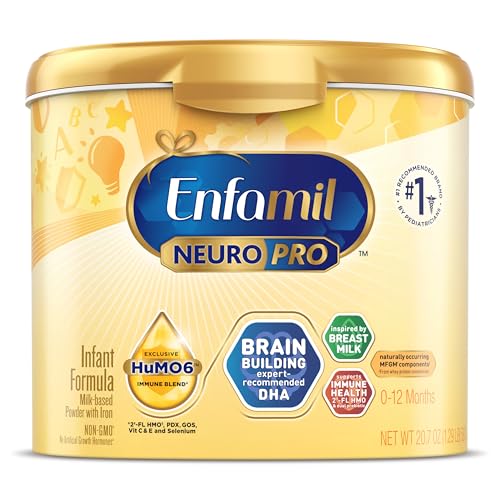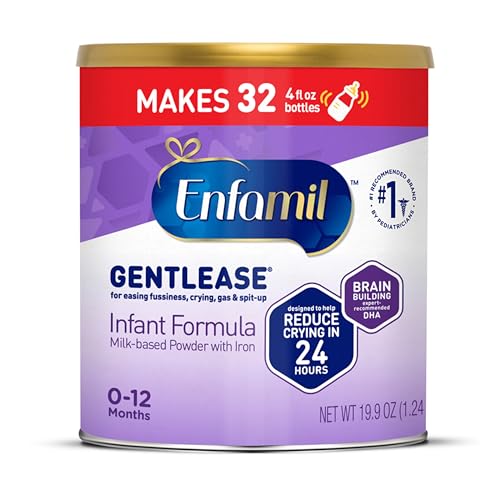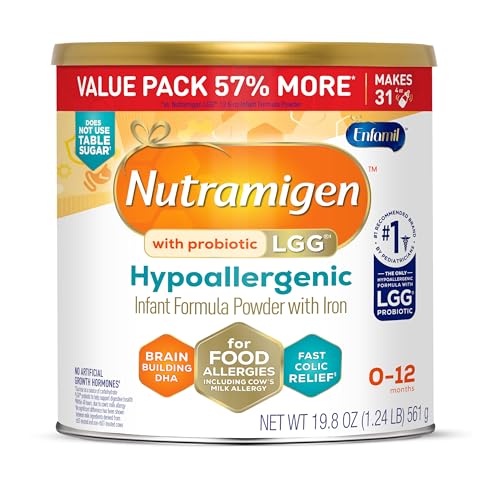Best Baby Formula for a New Infant
As an Amazon Associate I earn from qualifying purchases. Some links may earn us a commission at no extra cost to you.
For a newborn, what matters most is a safe, iron-fortified, complete infant formula that your baby tolerates well. Ready-to-feed (liquid) is sterile and convenient for the first weeks—especially for preterm or medically higher-risk infants—while powder is fine when prepared and stored correctly.
Top picks
Enfamil NeuroPro Infant — Best for most families starting formula
A balanced, iron-fortified cow’s-milk formula with intact proteins and DHA, offered in powder and sterile ready-to-feed.
Why it wins: It’s a mainstream 0–12-month formula with straightforward ingredients and RTF options for the early days.
- 5-YEAR BENEFIT: MFGM components clinically shown to support cognitive, motor & communication development now through age 5 when fed through baby's first year.
- NURTURING BRAIN DEVELOPMENT: Our formula has brain building nutrition, like MFGM components and expert-recommended DHA, known to support your baby's growing brain, fostering their development with confidence.
- HuMO6 IMMUNE BLEND§: Enfamil NeuroPro features our exclusive HuMO6 immune blend, to support your baby's immune system, because your baby's well-being is our top priority.
Pros
-
Intended for 0–12 months; easy transition
-
Intact protein; familiar taste profile
-
RTF bottles available for convenience
-
Widely stocked; easy to find
Cons
-
Includes palm-olein oil blend
-
Not ideal if reducing lactose is a priority
Social proof
Widely used, with extensive parent feedback—see reviews on Amazon.
Trade-offs / Who should skip
Try a “gentle” partially hydrolyzed option if gas/crying persist, or hypoallergenic with your pediatrician if cow’s-milk protein allergy is suspected.
Scores: Performance 4.5/5 · Digestive tolerance 4/5 · Ease of Use 4/5 · Value 4/5
Similac 360 Total Care — Best for prebiotic blend (5 HMOs)
Standard infant formula featuring a 5-HMO prebiotic blend and iron-fortified profile.
Why it wins: The HMO mix is designed to support gut/immune health.
Pros
-
5 HMOs; routine complete nutrition
-
Non-GMO ingredients listed by maker
-
Multiple can sizes and RTF options
-
Strong hospital presence
Cons
-
Not for infants with galactosemia
-
Prebiotic blend may not suit every tummy
Social proof
Large base of user feedback—see reviews on Amazon.
Trade-offs / Who should skip
For higher-risk newborns, consider RTF liquid for sterility regardless of brand.
Scores: Performance 4.5/5 · Digestive tolerance 4/5 · Ease of Use 4/5 · Value 3.8/5
Bobbie Organic Whole Milk Infant Formula — Best organic, lactose-only recipe
US-made, USDA Organic formula using whole milk, lactose as the only carb, and no palm oil.
Why it wins: Clean, organic recipe with whole-milk fats and a lactose-only carbohydrate; suitable from newborn to 12 months.
- CREAMY, RICH GRASS FED WHOLE MILK: Introducing an infant formula powder that provides full cream nutrition including whole milk from 365-day pasture-raised, grass-fed cows.
- A COMPLETE NUTRITION RECIPE: We've formulated this powdered whole milk formula with Iron, DHA, ARA, Vitamin D, Choline, and naturally occurring Milk Fat Globule Membrane (MFGM) from whole milk for healthy development and brain support.
- MODELED AFTER BREAST MILK: Our grass fed whole milk formula features a protein blend with a 60:40 whey-to-casein ratio (like mature breast milk) to support easy digestion.
Pros
-
USDA Organic; third-party tested
-
No palm oil; lactose-only carb
-
Whole-milk fat for creamier profile
-
Newborn-to-one-year suitability
Cons
-
Smaller 14.1-oz can; more reorders
-
Not a “gentle” hydrolysate formula
Social proof
Strong parent sentiment on ingredients—see reviews on Amazon.
Trade-offs / Who should skip
If your infant needs reduced lactose or broken-down proteins, choose a gentle or hypoallergenic option.
Scores: Performance 4.2/5 · Digestive tolerance 4.2/5 · Ease of Use 4/5 · Value 3.7/5
Enfamil NeuroPro Gentlease — Best “gentle” start for gas/fussiness
Partially hydrolyzed proteins and reduced lactose to help with common tummy troubles.
Why it wins: Same core nutrition as routine formulas but easier-to-digest proteins for fussy/gassy babies.
- GENTLE, EASY-TO-DIGEST BABY FORMULA: Made with proteins that are gentle on tiny tummies, specially designed to be easy to digest
- FAST COMFORT: Enfamil Gentlease baby formula is clinically shown to ease fussiness, crying, gas, and spit-up
- BRAIN SUPPORT FOR BABY'S FIRST YEAR: Enfamil Gentlease baby formula is made to have DHA & choline—nutrients that help support your baby's developing brain
Pros
-
Partially hydrolyzed whey; reduced lactose
-
Available in powder and RTF formats
-
Iron-fortified; 0–12-month nutrition
-
Mainstream availability for easy restock
Cons
-
Uses corn-syrup solids as carbohydrate
-
Includes palm-olein oil blend
Social proof
Popular “gentle” pick—see reviews on Amazon.
Trade-offs / Who should skip
If symptoms persist or allergy is suspected, move to hypoallergenic under pediatric guidance.
Scores: Performance 4.2/5 · Digestive tolerance 4.6/5 · Ease of Use 4/5 · Value 4/5
Nutramigen with Probiotic LGG — Best for diagnosed cow’s-milk protein allergy (with pediatrician)
Extensively hydrolyzed, lactose-free formula designed for CMA management; includes LGG probiotic.
Why it wins: It’s the mainstream EHF many pediatricians reach for first; specialty use only.
- HELPS EASE YOUR LITTLE ONE’S COLIC: Delivers clinically proven relief when managing colic due to cow’s milk allergy for a happier, better-rested baby and mom
- GENTLE, FAST RELIEF: As early as the first feeding, Nutramigen starts to reduce excessive crying in less than 24 hours * – a soothing solution for your little one
- SUPERSTAR LGG PROBIOTIC: The most extensively studied probiotic for allergy management that helps support your little one’s digestive health.
Pros
-
Extensively hydrolyzed casein proteins
-
Lactose-free for CMA protocols
-
Includes LGG probiotic strain
Cons
-
Bitter taste; infants may need time
-
Higher cost than routine formulas
Social proof
Longstanding specialty choice—see reviews on Amazon.
Trade-offs / Who should skip
Don’t buy unless CMA is suspected/diagnosed—talk to your pediatrician. Always check current lot guidance before use.
Scores: Performance 4.8/5 · Digestive tolerance 4.8/5 · Ease of Use 3.8/5 · Value 3.5/5
Quick compare (table-free)
-
Enfamil NeuroPro Infant — Best for most: Intact proteins; broad RTF options; includes palm-olein oils.
-
Similac 360 Total Care — Best prebiotics: 5 HMOs; iron-fortified; not for galactosemia.
-
Bobbie Organic Whole Milk — Best organic/lactose-only: No palm oil; whole-milk fats; smaller can size.
-
Enfamil NeuroPro Gentlease — Best gentle: Partially hydrolyzed + reduced lactose; uses corn-syrup solids.
-
Nutramigen LGG — Best hypoallergenic: Extensively hydrolyzed, lactose-free; specialty use with pediatrician.
Buying guide
-
Start with iron-fortified routine formula. For most full-term infants, a standard cow’s-milk, iron-fortified formula is appropriate from birth to 12 months.
-
Powder vs. ready-to-feed (RTF). Powder is convenient but not sterile. For babies under 2 months, preemies, or medically fragile infants, liquid RTF is the safer default because it’s sterile. If you use powder, follow hot-water prep steps and storage rules exactly.
-
When to try “gentle.” If your newborn has ongoing gas/crying after several days on a routine formula, a partially hydrolyzed/reduced-lactose option can help. Give any change 3–5 days unless your pediatrician advises otherwise.
-
When to go hypoallergenic. For suspected cow’s-milk protein allergy (eczema, blood/mucus in stool, persistent vomiting), use an extensively hydrolyzed or amino-acid-based formula under pediatric care.
-
Organic & ingredient preferences. Organic, lactose-only, and palm-oil-free recipes are preferences, not necessities. Match the recipe to your priorities and your baby’s tolerance.
-
Not medical advice. Always loop in your pediatrician for feeding decisions, especially for preemies, growth concerns, or special diets.
FAQs
Q: Is liquid formula safer for a brand-new infant?
A: For the first weeks—especially under 2 months or preterm—ready-to-feed liquid is sterile and a safer default. Powder needs careful prep.
Q: Can I switch formulas if something seems off?
A: Yes. Most babies tolerate a switch within 3–5 days; call your pediatrician sooner for severe symptoms.
Q: Do newborns need special “newborn” formulas?
A: Not typically. A standard iron-fortified infant formula labeled for 0–12 months is the norm unless your pediatrician specifies otherwise.
Q: Should I avoid formulas with corn-syrup solids or palm oil?
A: These are common ingredients and often well-tolerated. If you prefer palm-oil-free or lactose-only, options exist (e.g., Bobbie).
As an Amazon Associate, I earn from qualifying purchases.





